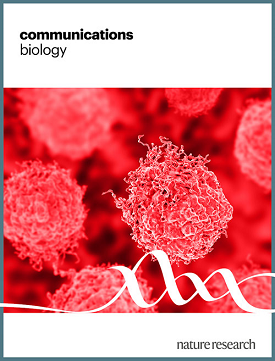Insights into the cotranscriptional and translational control mechanisms of the Escherichia coli tbpA thiamin pyrophosphate riboswitch
IF 5.2
1区 生物学
Q1 BIOLOGY
引用次数: 0
Abstract
Riboswitches regulate gene expression by modulating their structure upon metabolite binding. These RNA orchestrate several layers of regulation to achieve genetic control. Although Escherichia coli riboswitches modulate translation initiation, several cases have been reported where riboswitches also modulate mRNA levels. Here, we characterize the regulation mechanisms of the thiamin pyrophosphate (TPP) tbpA riboswitch in E. coli. Our results indicate that the tbpA riboswitch modulates both levels of translation and transcription and that TPP sensing is achieved more efficiently cotranscriptionally than post-transcriptionally. The preference for cotranscriptional binding is also observed when monitoring the TPP-dependent inhibition of translation initiation. Using single-molecule approaches, we observe that the aptamer domain freely fluctuates between two main structures involved in TPP recognition. Our results suggest that translation initiation is controlled through the ligand-dependent stabilization of the riboswitch structure. This study demonstrates that riboswitch cotranscriptional sensing is the primary determinant in controlling translation and mRNA levels. In vivo and in vitro studies of an Escherichia coli riboswitch highlights the role of cotranscriptional metabolite sensing and the mechanism of gene regulation.揭示大肠杆菌 tbpA 硫胺素焦磷酸核糖开关的共转录和翻译控制机制
核糖开关在与代谢物结合后通过调节其结构来调控基因表达。这些核糖核酸协调多层调控,实现基因控制。尽管大肠杆菌核糖开关调节翻译起始,但也有报道称核糖开关也调节 mRNA 水平。在这里,我们描述了大肠杆菌中焦磷酸硫胺素(TPP)tbpA 核糖开关的调控机制。我们的研究结果表明,tbpA 核糖开关可同时调节翻译和转录水平,而且 TPP 的共转录感应比转录后感应更有效。在监测 TPP 依赖性抑制翻译启动时,也观察到了同转录结合的偏好。利用单分子方法,我们观察到适配体结构域在参与 TPP 识别的两种主要结构之间自由波动。我们的研究结果表明,翻译启动是通过核糖开关结构的配体依赖性稳定来控制的。这项研究表明,核糖开关的共转录感应是控制翻译和 mRNA 水平的主要决定因素。对大肠杆菌核糖开关的体内和体外研究凸显了共转录代谢物感应的作用和基因调控机制。
本文章由计算机程序翻译,如有差异,请以英文原文为准。
求助全文
约1分钟内获得全文
求助全文
来源期刊

Communications Biology
Medicine-Medicine (miscellaneous)
CiteScore
8.60
自引率
1.70%
发文量
1233
审稿时长
13 weeks
期刊介绍:
Communications Biology is an open access journal from Nature Research publishing high-quality research, reviews and commentary in all areas of the biological sciences. Research papers published by the journal represent significant advances bringing new biological insight to a specialized area of research.
 求助内容:
求助内容: 应助结果提醒方式:
应助结果提醒方式:


